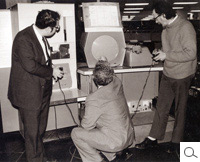
Definition of IT
Information technology (IT) is the application of computers and telecommunications equipment to store, retrieve, transmit and manipulate data, often in the context of a business or other enterprise. The term is commonly used as a synonym for computers and computer networks, but it also encompasses other information distribution technologies such as television and telephones. Several industries are associated with information technology, such as computer hardware, software, electronics, semiconductors, internet, telecom equipment, e-commerce and computer services.
In a business context, the Information Technology Association of America has defined information technology as "the study, design, development, application, implementation, support or management of computer-based information systems". The responsibilities of those working in the field include network administration, software development and installation, and the planning and management of an organisation's technology life cycle, by which hardware and software is maintained, upgraded, and replaced.

History of IT
Humans have been storing, retrieving, manipulating and communicating information since the Sumerians in Mesopotamia developed writing in about 3000 BC, but the term "information technology" in its modern sense first appeared in a 1958 article published in the Harvard Business Review; authors Harold J. Leavitt and Thomas L. Whisler commented that "the new technology does not yet have a single established name. We shall call it information technology (IT)." Based on the storage and processing technologies employed, it is possible to distinguish four distinct phases of IT development: pre-mechanical (3000 BC – 1450 AD), mechanical (1450–1840), electromechanical (1840–1940) and electronic (1940–present). This article focuses on the most recent period (electronic), which began in about 1940.

History of Computers
Devices have been used to aid computation for thousands of years, probably initially in the form of a tally stick. The Antikythera mechanism, dating from about the beginning of the first century BC, is generally considered to be the earliest known mechanical analog computer; it is also the earliest known geared mechanism. Comparable geared devices did not emerge in Europe until the 16th century, and it was not until 1645 that the first mechanical calculator capable of performing the four basic arithmetical operations was developed. Electronic computers, using either relays or valves, began to appear in the early 1940s. The electromechanical Zuse Z3, completed in 1941, was the world's first programmable computer, and by modern standards one of the first machines that could be considered a complete computing machine. Colossus, developed during the Second World War to decrypt German messages was the first electronic digital computer. Although it was programmable, it was not general-purpose, being designed to perform only a single task. It also lacked the ability to store its program in memory. Instead, programming was carried out using plugs and switches to alter the internal wiring. The first recognisably modern electronic digital stored-program computer was the Manchester Small-Scale Experimental Machine (SSEM), which ran its first program on 21 June 1948

History of Games
Back in 1962, MIT students Slug Russell, Shag Graetz, and Alan Kotok wrote SpaceWar!, considered the first interactive computer game. First played at MIT on DEC´s PDP-1, the large-scope display featured interactive, shoot´em-up graphics that inspired future video games. Dueling players fired at each other´s spaceships and used early versions of joysticks to manipulate away from the central gravitational force of a sun as well as from the enemy ship.

NOTE: The PDP-1 served as the platform for a wide variety of "firsts". Among the list are the first text editor, word processor, interactive debugger, the first credible computer chess program, and some of the earliest computerized music.








